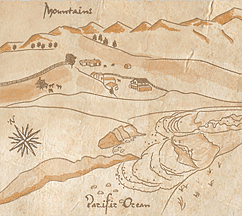
Hand-drawn diseño: Rancho Nuestra Señora del Refugio (Rancho Esperanza)

Sylvester Jourdain, A Discovery of the Barmudas
“The ship sat keel down in a sand hole between two corals jaws, surrounded by a scattering of ballast stones, cannonballs, and shards of pottery, along with other odds and ends. A canon was wedged mouth down in he coral about twenty-five feet from what remained of this ship’s worm-eaten keel. All the ship’s bones and the scattered artifacts were encrusted with barnacles that turned the ship into a seeming extension of the reef itself.”
Kieran Doherty, Sea Venture
Cowboy Surfer’s Journal
“Even Wellsian stories can touch on the real other world of the Spirit. These kinds of stories that create regions of the spirit—they actually add to life, don’t they? They’re like some dreams that only come from time to time—they give us sensations we’ve never had before. You could say they enlarge our very idea of what’s possible in human experience.”
—C.S. Lewis in conversation with J.R.R. Tolkien

Book 1, “The Lost Ember”
James Jordan is delighted to introduce his first work of fiction, the anthology, Cowboy Surfer’s Journal (CSJ). The initial installment of this debut collection, “The Lost Ember”, is the fruit of a shared vision with his extraordinary writing partners—Boccaccio, Borges, Eco, Campanella, Marquez and Tolkien—to name a few significant influences. Sir Isaac Newton famously wrote, “If I have seen farther, it is because I have stood on the shoulders of giants.” (This phrase is originally attributed to Bernard of Chartres.) With a view forward, CSJ is a modern piece, its prose is sheer elegance and refinement brought to life by the echo of old world masters, and the resonance of modern storytellers.
In keeping with Jordan’s personal style and literary philosophy, Cowboy Surfer’s Journal represents an ideal union of the following: a sweeping and epic style of narration, providing a prominent sense of place and time (think David Lean—Dr. Zhivago or Lawrence of Arabia), intimate and non-judgmental character development, a classical twist stylistically to assure richness and grandeur in content, with a generosity toward the reader providing access without dumbing down the overall experience, and an overriding contemporary composition to capture today’s tastes and lifestyles, accomplished through artisan handcraft (think “word”-smith).
To understand his vision and philosophy, you must first understand its place of origin. Jordan’s ancestor, Samuel Jordan, or Jourdain, was of French descent, born in Wiltshire England in 1578. The Jourdains were Huguenots associated with the protestant reformation. Samuel arrived at Jamestown, Virginia in 1610, after having sailed aboard the Sea Venture, the Virginia Company’s Third Supply, sailing with such notable figures as Christopher Newport, John Smith and John Rolfe. The Sea Venture encountered an extreme storm or hurricane, and became cast away on Bermuda, before being salvaged and converted to two smaller ships, Deliverance and Patience, which carried passengers and supplies to the nascent colony. Historians, as well as family records, indicate the well-documented storm, recorded by Sylvester Jourdain, Samuel’s cousin, in “A Discovery of the Barmudas”, and circulated in England shortly after the passengers of the Sea Venture became cast-a-way. Evidently, a friendship between the inimitable bard (William Shakespeare) and Samuel Jourdain, influenced the creation of “The Tempest”.
Samuel went on to hold the second extant land patent in the New World, sharing a property line with Rolfe and his bride, Pocahontas, while serving in the in the fledgling colony’s first legislative assembly, the House of Burgess.
Jordan is inspired by his ancestors, a family with a long history of land stewardship and public service, but is also influenced by his birthplace—the exquisite, Mediterranean flavored coast of California. It was here, surrounded by classic mission architecture, immersed in an amalgam of rancho and beach culture, and blessed with parents of impeccable taste in art, apparel and architecture, well traveled and generous of nature, that he first developed the ascetic/aesthetic sensibility that has shaped his love of language and history.
Now his interests are split between the stories that inhabit the gracious ruins of Spanish settlements along California’s golden shores, storied ranchos that defined the quintessential “work hard, play hard” lifestyle that has made Alta California the essential model for modern Western aesthetics, and the birthplace of its early makers—Spain—home of the: conquistadors, noblemen, priests and explorers, along with being the epicenter of Medieval and Renaissance history within the Mediterranean.
“From the beginning, my intention in creating Cowboy Surfer’s Journal has been to inform the reader, entertain, and suggest the creative potential we have within ourselves is great. As we explore humanity’s unique passion for living and creating beauty, we see the evidence of joy. I want people to discover joy, to taste the love of life that defends against all uncertainty: il succo della vita, the juice of life. James Jordan is about living with dignity and passion; it’s about embracing life in all its beauty, and following one’s own path. Now, in marrying this dream to the genius of voices past, my literary mentors, I believe I have accomplished what I set out to do. The Lost Ember is the beginning of this journey, Volume One of the Cowboy Surfer’s Journal.
This is your life! Take it! Live it!”
James Jordan
Sedona, Arizona—Dec. 12, 2012
